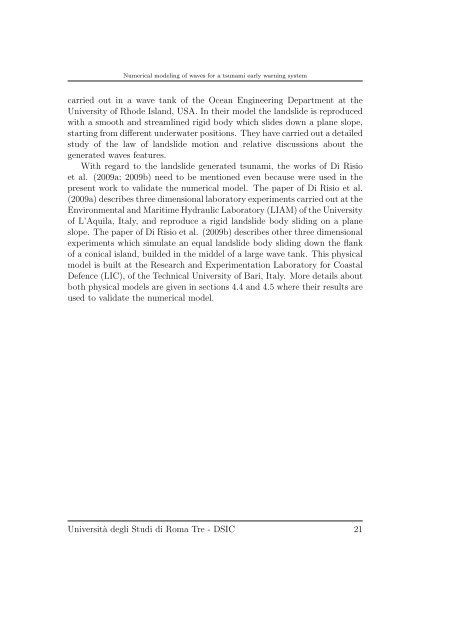Numerical modeling of waves for a tsunami early warning system
Numerical modeling of waves for a tsunami early warning system
Numerical modeling of waves for a tsunami early warning system
You also want an ePaper? Increase the reach of your titles
YUMPU automatically turns print PDFs into web optimized ePapers that Google loves.
<strong>Numerical</strong> <strong>modeling</strong> <strong>of</strong> <strong>waves</strong> <strong>for</strong> a <strong>tsunami</strong> <strong>early</strong> <strong>warning</strong> <strong>system</strong><br />
carried out in a wave tank <strong>of</strong> the Ocean Engineering Department at the<br />
University <strong>of</strong> Rhode Island, USA. In their model the landslide is reproduced<br />
with a smooth and streamlined rigid body which slides down a plane slope,<br />
starting from different underwater positions. They have carried out a detailed<br />
study <strong>of</strong> the law <strong>of</strong> landslide motion and relative discussions about the<br />
generated <strong>waves</strong> features.<br />
With regard to the landslide generated <strong>tsunami</strong>, the works <strong>of</strong> Di Risio<br />
et al. (2009a; 2009b) need to be mentioned even because were used in the<br />
present work to validate the numerical model. The paper <strong>of</strong> Di Risio et al.<br />
(2009a) describes three dimensional laboratory experiments carried out at the<br />
Environmental and Maritime Hydraulic Laboratory (LIAM) <strong>of</strong> the University<br />
<strong>of</strong> L’Aquila, Italy, and reproduce a rigid landslide body sliding on a plane<br />
slope. The paper <strong>of</strong> Di Risio et al. (2009b) describes other three dimensional<br />
experiments which simulate an equal landslide body sliding down the flank<br />
<strong>of</strong> a conical island, builded in the middel <strong>of</strong> a large wave tank. This physical<br />
model is built at the Research and Experimentation Laboratory <strong>for</strong> Coastal<br />
Defence (LIC), <strong>of</strong> the Technical University <strong>of</strong> Bari, Italy. More details about<br />
both physical models are given in sections 4.4 and 4.5 where their results are<br />
used to validate the numerical model.<br />
Università degli Studi di Roma Tre - DSIC 21

















